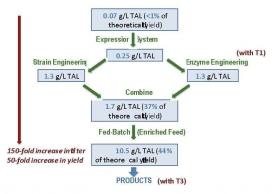Researchers Demonstrate Route to Commercially Viable Levels of Important Platform Molecule
Researchers at the Center for Biorenewable Chemicals (CBiRC), an NSF-funded Engineering Research Center (ERC) headquartered at Iowa State University (ISU), have substantially increased the synthesis of an important platform molecule known as TAL (triacetic acid lactone). This increase was accomplished in the yeast Saccharomyces cerevisiae.
Following synthesis in a microbial host, TAL can be transformed into an array of diverse chemicals; for example, other CBiRC researchers have demonstrated the conversion to products ranging from sorbic acid to pogostone (a natural product of interest because of its antimicrobial, antifungal, and anti-inflammatory activity). The advances in microbial TAL production thus demonstrate a successful route for obtaining commercially viable levels of this key molecule. In addition, similar approaches will prove useful for the high-level synthesis of related products.
TAL is an ideal platform molecule for the synthesis of an array of materials, including bioactive natural products and specialty chemicals. The ability to dramatically increase its production is significant for the chemical industry.
A three-step combination of engineering (1) the yeast expression system, (2) the 2-pyrone synthase enzyme (for increased stability and activity), and (3) the relevant metabolic pathways (to increase carbon flux to TAL) led to substantial increases in the production of TAL by S. cerevisiae (see figure). A further 10-fold increase in TAL titer was then accomplished via fed-batch culture in a bioreactor using a high-concentration glucose feed supplemented with nitrogen-containing amino acids for a 35:1 (g/g) carbon-to-nitrogen ratio. Feed rate was varied to maintain dissolved oxygen levels at 20%. In this system, TAL yield also increased significantly, reaching 44% of maximum theoretical yield.


